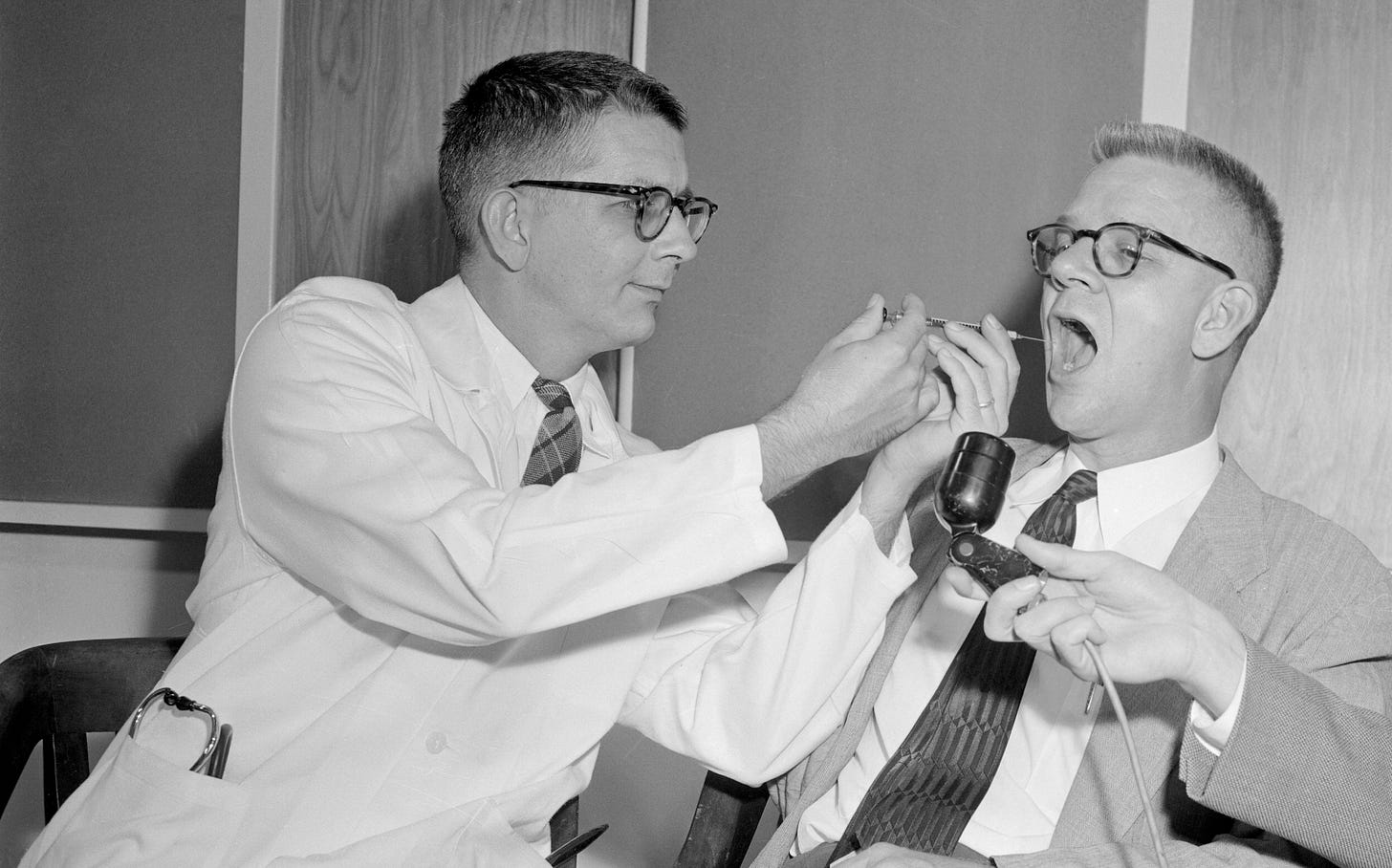Psychedelics Go Mainstream, Kind Of
The psychedelic renaissance has struggled to shed the habits of the underground.
Have questions about this disorienting time? Join Persuasion’s editor-in-chief Yascha Mounk for a live, virtual Q&A in which he will answer any questions you might have about his writing or this political moment! We’ll be meeting today, Tuesday February 25th, at 6pm Eastern. Join us by clicking on the button below!

Since psychedelic drugs were made illegal in 1970, they have occupied a small, relatively stable corner in Western culture. Roughly 1% of Americans used psychedelic drugs in any given year. Many of them were students or occasional ravers. And then there was also a small, relatively-stable “psychedelic underground,” in which psychedelic drugs were a central part of members’ beliefs, identity, culture, and even livelihood.
This “psychedelic underground” was previously considered somewhat deviant and its devotees could sometimes be stigmatized as “druggies,” “freaks,” or “hippies,” partly because their preferred activity was illegal. Nonetheless, the underground had its more establishment denizens—a few high-net-worth bohemians in the East and West Coast elite, and a handful of renegade scientists who continued the research of the 1950s and ’60s. Until recently, you could fit the entire psychedelic research community in one large tent.
The psychedelic underground was a niche subculture, with its own rituals, terminology and sacred sites, its heroes, and its Dionysian ethics of altered states, blurred boundaries, and psychedelic polyamory. When harm, misconduct, rapes, or deaths occurred, they were rarely reported and generally accepted. This was the jungle, literal or metaphorical.
What’s happened in the last five years is this underground has gone overground and attracted millions of newbies, and it’s now set to become part of mainstream U.S. mental healthcare. The question is: can psychedelic culture shed the Dionysian ethics of the underground and become professionalized, bureaucratized and normal? What would be gained by that? And what lost?
The Underground Goes Overground
The story of the “psychedelic renaissance” has often been told, so here’s a very brief version. Around two decades ago psychedelic research re-started at places like Imperial College London and Johns Hopkins Medical School. Clinical trials of psilocybin, MDMA, DMT, and other drugs showed a lot of promise as mental health treatments.
These trials attracted a steadily-growing amount of media interest, especially from Joe Rogan’s podcast, Netflix documentaries like Fantastic Fungi, and Michael Pollan’s 2018 book How To Change Your Mind. All the positive press eventually helped to inspire a so-called “shroom boom” in investment. In 2020-2021, psychedelic companies touting medical breakthroughs raised billions on stock exchanges.
Psychedelic organizations also attracted hundreds of millions in philanthropic funding, especially an organization called Multidisciplinary Association for Psychedelic Science (MAPS). In the last few years, MAPS has been adopted by a coterie of American millionaires and billionaires, particularly from Silicon Valley, who see psychedelics as a new technology to heal the sick and maybe even upgrade humanity.
The same philanthropists backed successful ballot initiatives to launch legal psychedelic programs in Oregon in 2020 and Colorado in 2022. These programs haven’t had that many customers yet—they’re expensive, with a single psychedelic experience costing between $500 and $2,000. Instead, the wave of psychedelic hype over the last five years has had two main real-world impacts.
The first is a boom in ketamine clinics in the United States. Ketamine is not a traditional psychedelic, but has ridden the coat-tails of the psychedelic renaissance and become both a popular legal mental health treatment and a fashionable illegal relaxant in the United States. Spravato, a ketamine nasal spray, now makes Johnson & Johnson over a billion dollars a year.
The second impact of psychedelic hype is a boom in the use of psychedelics outside of medical settings, either in the underground or in retreats abroad. Use of psilocybin doubled among Americans between 2018 and 2021, from 3% to 6% of the adult population.
This is the paradox of the psychedelic renaissance—it attracted a lot of positive media with the pitch that, this time around, the psychedelic revolution would be safer than the crazy 1960s, because people would only take psychedelic medicine under safe medical conditions. But it takes a long time to get drugs FDA-approved, and even then they’ll be hard to get. In the meantime, the renaissance created a surge in demand which could only be met in the underground or in psychedelic retreats abroad—in much less safe, controlled conditions than the clinical trials that we read about in The New York Times.
The underground is now overground. Psychedelic guides, retreats, churches and vendors advertise on TikTok and Instagram without fear of legal consequences. There are hundreds of “psychedelic facilitator” training courses, including some at prestigious universities, all training people for a legal market that does not yet exist (except for ketamine). All those thousands of graduates will go and work in the underground. The sort of New Age terminology once only found in niche Californian circles—“integration,” “shadow work,” “holding space”—has now become part of mainstream wellness culture through social media.
Underground drug culture has become normalised. The DJ Diplo goes on CNN on New Year’s Eve and says he is on LSD. No big deal. They’re not even called “drugs” anymore, but rather “medicine.” Everything is “medicine” in psychedelic culture. Taking a bump of ketamine is “medicine,” having sex with your partner on molly is “medicine,” going on a retreat where you take a different drug each night is “medicine.”
Bumps in the Road
Last year, the road to psychedelic utopia hit various bumps. MAPS’ public benefit corporation spin-off, Lykos, was the first psychedelic start-up to apply for FDA approval for its treatment. In August 2024 it got turned down. FDA insiders say Lykos failed to collect some important safety data, and there were doubts about the quality of the data it submitted. Other influential organizations like Cochrane and the Institute for Clinical and Economic Review also expressed doubts about the reliability of psychedelic science. What if the researchers are quasi-religious “true believers” with one foot in the underground?
Despite tens of millions of dollars in donations from the psychedelic elite, attempts to legalize psychedelics in California and Massachusetts failed. And there were some high-profile incidents of psychedelic harm. About 9% of people experience difficulties lasting longer than a day after taking psychedelics. These difficulties can last a few days, several months or years. The most common are increased anxiety, social withdrawal, sleep disturbances, visual distortions, derealization, and existential confusion. In rare cases they can precipitate psychosis or mania.
There’s still a lot we don’t know. For example, how many people die on psychedelic retreats each year? The U.S. Embassy in Peru warned last month that several Americans had died at ayahuasca retreats last year. None made the news—it all stayed in the underground.
Because of the underground’s code of silence, we have no clear picture of the harms that occur in unregulated spaces. In the underground, there is very little screening, very little information given to clients about risks, and very little integration or support afterwards. The underground is high on confidence and low on evidence.
If you are one of the 4% or so who get into serious post-psychedelic difficulties, you may spend months or years and many thousands of dollars desperately trying to return to normal functioning. There is hardly any research on post-psychedelic harms and no recommended treatments. The unlucky few can be left wondering: “Am I psychotic?” “Am I possessed?” “Do I need medication or an exorcism?”
And then there are the violations which occur in the underground—therapists and guides taking advantage of clients’ increased suggestibility to have sex with them, or to convert them to their worldview or business pitch. There’s the cultiness, the dodgy gurus, malevolent brujos, the spells and curses, the encounters with daemonic entities, the knee-shaking WTF-ness of psychedelics.
All the darker parts of the psychedelic underground that old-timers knew about and accepted as the law of the jungle are now above ground, exposed to the harsh light of the mainstream, and they’re a rude awakening for the newbies who read Michael Pollan and expected a nice suburban mystical experience.
Two New Hopes
But despite recent setbacks, the movement is hopeful. It still has powerful backers in the psychedelic elite, willing to spend hundreds of millions to get their favourite drugs legalized. At the moment, Antonio Gracias, close friend of Elon Musk’s and a shareholder in Tesla, is bidding to take over Lykos and give it the money it needs to run new clinical trials of MDMA, to finally get it FDA-approved. Or maybe Lykos won’t need to do another trial after all. Some psychedelic enthusiasts are optimistic that Robert F. Kennedy Jr., newly-confirmed Secretary of Health and Human Services, will help usher in legal access to psychedelics (he and many of his advisors have spoken in support of psychedelic medicines).
The fact that the future of psychedelics might depend on Donald Trump’s government is creating cognitive dissonance for left-leaning psychonauts. They thought of the movement as a grassroots, progressive, decolonizing space that would heal polarization, end the racist war on drugs, and bring the world into polyamorous non-binary oneness. “If only world leaders could all take psychedelics!” Well, at least one (sort of) world leader has—Elon Musk—and he got red-pilled. What price is the movement willing to pay to get psychedelics legalized?
Perhaps the biggest question mark for the movement is how above-ground psychedelic medicine will relate to the underground. The FDA often worries about drug diversion. But psychedelics have already been diverted and always will be. They grow out of the ground. Accidents and scandals will continue to occur—could they end up giving these substances a bad reputation or provoking a backlash?
It’s hard to predict what will occur. A part of me suspects psychedelics are simply too weird to ever become part of mainstream culture—they never did in Brazil (where ayahuasca churches are legal) or in Holland (where you can buy psychedelic truffles in Amsterdam cafés). According to this scenario, some psychedelic medicines will be legalized and tightly controlled in the next two years, while the underground carries on doing what it does as a minor subculture, without changing Western culture in any dramatic way.
On the other hand, the old technocratic mainstream is itself breaking down. The bizarre and the fringe is the new normal. The psychedelic underground has become the psychedelic establishment. Things could get very weird indeed.
Jules Evans is the author of four books including Philosophy for Life and Other Dangerous Situations (2012) and The Art of Losing Control (2017). He is director of the Challenging Psychedelic Experiences Project, an NGO that researches post-psychedelic difficulties and what helps people recover from them, and which works to improve psychedelic safety. He edits the Substack www.ecstaticintegration.org.
Follow Persuasion on X, LinkedIn, and YouTube to keep up with our latest articles, podcasts, and events, as well as updates from excellent writers across our network.
And, to receive pieces like this in your inbox and support our work, subscribe below:






Legalise it! :)
The problem with clinically evaluating psychedelics is separating out the "feel good" effects of the treatments from potential medicinal effects. If ethyl alcohol were an underground drug rather than in widespread use, would some people claim that it had medicinal properties? Also, if one or more psychedelic drugs were proven to have medicinal properties, then those drugs would be regulated at least as prescription drugs and, potentially, as controlled substances. Recreational use would still be illegal.